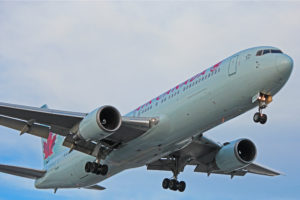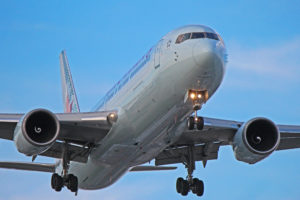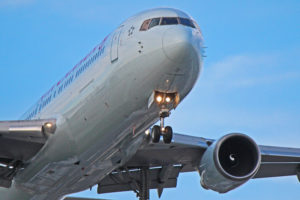 By the looks of the tattered paint at the top of the tail on C-GLCA, this Boeing 767-300ER is a prime candidate to be next for the new Air Canada livery. Question is, will they bother. This is one of ten B763 aircraft remaining in the AC main fleet with five to be phased out by the end of 2018. There’s always the possibility the aircraft will be shifted to the Air Canada Rouge fleet, a subsidiary the relishes in their Boeing 767’s.
By the looks of the tattered paint at the top of the tail on C-GLCA, this Boeing 767-300ER is a prime candidate to be next for the new Air Canada livery. Question is, will they bother. This is one of ten B763 aircraft remaining in the AC main fleet with five to be phased out by the end of 2018. There’s always the possibility the aircraft will be shifted to the Air Canada Rouge fleet, a subsidiary the relishes in their Boeing 767’s.
We photographed C-GLCA on August 13, 2017 while plane spotting at Toronto Pearson International Airport (YYZ). For full-size, high resolution versions of any of the photos in the image gallery, simply click on the individual pictures. See below for more detailed information on C-GLCA, the Boeing 767-300ER model in general and the airline.
Image Gallery
C-GLCA
Boeing 767-300ER
Air Canada
Resources
C-GLCA Air Canada Boeing 767-300ER Image Gallery
C-GLCA
C-GLCA took its first flight on March 15, 1991 and was delivered to Canadian Airlines on April 5, 1991. The aircraft was transferred to Air Canada on March 29, 2001 after AC acquired Canadian. The B763 is configured for a maximum total of 211 passengers with 24 seats in business class and 187 more in economy class.
As mentioned, this is one of ten Boeing 767-300ER airplanes remaining in the Air Canada main fleet. There are 24 more in the Air Canada Rouge fleet. Five are to be phased out by the end of 2018, replaced by Boeing 787-9 Dreamliner models.
As with any Boeing 767-300ER, C-GLCA has had its fair share of troubles. On December 11, 2014, the airplane was flying from Toronto, Ontario to Calgary, Alberta when the centre hydraulic system’s pressure and quantity indicators dropped to zero. The B763 landed safely at YYC (Calgary). It was found that the slat/flap shutoff valve module had failed.
A few weeks later, on December 29, 2015, the aircraft was flying from Calgary to London, England. Northwest of Greenland, the crew received a ‘No Land 3’ indication followed by the loss of the first officer’s flight director. An acrid odour was also detected in the cockpit. Instead of continuing on over the Atlantic Ocean, the Boeing 767-300ER was diverted back to Toronto, landing safely nearly four hours later. As a result, the right flight control computer was replaced.
On July 30, 2015, C-GLCA was flying from Toronto, Ontario to Paris, France. 200 miles out of Toronto, the crew turned back after receiving a ‘R ENG HPSOV’ indication, landing safely in Toronto nearly an hour later. A connector in the right wing pylon was found to be loose and was responsible for the indication. The connector was tightened and secured.
On October 20, 2015, the B763 was flyig from London, England to Toronto. On takeoff and through the initial climb, the crew observed the throttles staggered and the left hand engine did not achieve full climb thrust. The climb was stopped at 12,000 feet and the aircraft returned to London for a safe landing. This resulted in the left side engine’s fuel pump and hydro-mechanical unit being replaced.
Quite recently, a few weeks before we photographed C-GLCA, it ran into some engine trouble. On July 28, 2017, the Boeing 767-300ER was flying from Toronto to Ottawa. On the initial climb, the left side engine began to surge and streaks of flames were observed from the engine exhaust. The climb was halted at 5,000 feet and the aircraft returned safely to YYZ. As a result, the left side engine was replaced.
Boeing 767-300ER
The Boeing 767-300ER first entered service in 1988 with American Airlines. In total, 583 were delivered. The B763 is 55 metres or 180 feet in length with a wingspan of 48 metres or 156 feet. At the tail, the airliner stands 16 metres or 52 feet in height. The flight range is 11,070 kilometres.
Air Canada
Founded in 1937, Air Canada is headquartered on the grounds of Montreal Pierre Elliott Trudeau International Airport (YUL) in Dorval, Quebec. The airline has a fleet of around 175 aircraft in the main fleet, flying to over 200 destinations around the world. Including subsidiaries, those numbers increase to just under 400 aircraft flying to 350 destinations worldwide.
Air Canada is a founding member of the Star Alliance. The alliance now has 27 full member airlines. Other founding members include Lufthansa, Scandinavian Airlines, Thai Airways and United Airlines.
Resources
Toronto Pearson International Airport
Pierre Elliott Trudeau International Airport




